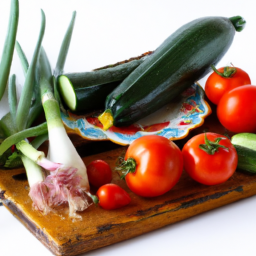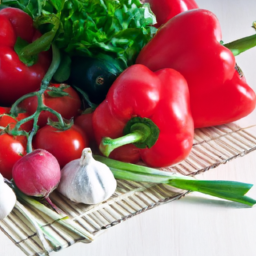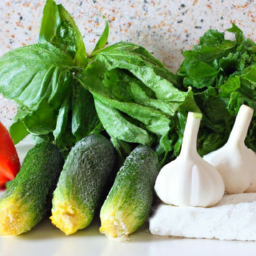
Are you looking to add some greenery to your indoor space? Growing your own vegetables indoors is a great way to bring some life and freshness into your home. In this blog post, we will discuss the best indoor vegetables that you can easily grow in your own home. Whether you have a green thumb or are new to gardening, these vegetables are perfect for indoor cultivation. So, let’s dive in and explore the world of the best indoor vegetables!
Benefits of Growing Indoor Vegetables
Increased Control Over Growing Conditions
One of the main benefits of growing indoor vegetables is the increased control over growing conditions. When you grow vegetables indoors, you have the ability to control the temperature, humidity, and light levels to create the ideal environment for your plants to thrive. This can result in healthier plants and higher yields compared to growing outdoors where you are at the mercy of the weather.
Additionally, growing vegetables indoors allows you to extend the growing season and grow a wider variety of crops that may not be well-suited for your climate. This means you can enjoy fresh, homegrown produce year-round, regardless of the weather outside.
By growing vegetables indoors, you can also avoid common outdoor gardening challenges such as pests, diseases, and extreme weather events that can negatively impact your plants. This can result in a more consistent and reliable harvest of high-quality vegetables.
Space Efficiency
Another benefit of growing indoor vegetables is the space efficiency it offers. Indoor gardening allows you to make the most of limited space, making it ideal for those who live in apartments, condos, or homes with small yards. You can set up a small indoor garden on a windowsill, countertop, or shelf, or invest in a vertical gardening system to maximize your growing space.
Indoor gardening also allows you to grow vegetables in areas where outdoor gardening may not be feasible, such as in urban environments or in regions with poor soil quality. This can open up new possibilities for growing your own food and connecting with nature, even in the most unlikely of places.
Furthermore, growing vegetables indoors can be a fun and rewarding hobby that can be enjoyed by people of all ages. It can provide a sense of accomplishment and satisfaction as you watch your plants grow and produce delicious, homegrown vegetables right in your own home.
Health Benefits
Growing indoor vegetables can also have numerous health benefits. By growing your own vegetables, you have full control over how they are grown and can ensure they are free from harmful chemicals and pesticides. This can result in healthier, more nutritious vegetables that are better for you and your family.
Additionally, indoor gardening can provide mental health benefits such as stress relief, improved mood, and a sense of well-being. Taking care of plants and watching them grow can be a therapeutic and calming experience that can help reduce anxiety and improve overall mental health.
Finally, growing your own vegetables can encourage you to eat more fresh produce and incorporate a wider variety of vegetables into your diet. This can lead to improved nutrition, better health outcomes, and a greater appreciation for the food you eat.

Top Indoor Vegetables for Small Spaces
Introduction
Indoor gardening is a great way to bring greenery into your home, even if you have limited space. Growing vegetables indoors can be a rewarding experience and provide you with fresh, homegrown produce all year round. In this article, we will explore the best indoor vegetables for small spaces, along with tips on how to care for them.
Tomatoes
Tomatoes are a popular choice for indoor gardening due to their versatility and delicious flavor. They can be grown in containers and require plenty of sunlight to thrive. Choose dwarf or cherry tomato varieties for small spaces, as they are more compact and suitable for indoor growing. Make sure to provide support for the plants as they grow, such as stakes or trellises.
Water tomatoes regularly, allowing the soil to dry out slightly between waterings. Fertilize every few weeks with a balanced fertilizer to promote healthy growth and fruit production. Prune the plants as needed to encourage airflow and prevent disease. With proper care, you can enjoy a bountiful harvest of fresh tomatoes right from your indoor garden.
Tomatoes are versatile vegetables that can be used in a variety of dishes, from salads to sauces. Having fresh tomatoes at your fingertips can elevate your cooking and provide you with a sense of satisfaction knowing that you grew them yourself.
Herbs
Herbs are another great option for indoor gardening, as they are easy to grow and require minimal space. Popular herbs to grow indoors include basil, parsley, mint, and chives. These herbs can be grown in small pots or containers on a sunny windowsill or under grow lights.
Herbs require well-draining soil and regular watering to thrive. Harvest the leaves as needed to encourage new growth and prevent the plants from becoming leggy. You can also dry or freeze excess herbs for later use, allowing you to enjoy fresh flavors year-round.
Having a selection of fresh herbs at your disposal can enhance your culinary creations and add a burst of flavor to your dishes. Growing herbs indoors is a rewarding experience that can also save you money on store-bought herbs.
Peppers
Peppers are a colorful and flavorful addition to any indoor garden. Choose compact pepper varieties, such as bell peppers or chili peppers, for small spaces. Peppers require plenty of sunlight and warm temperatures to thrive, so place them in a sunny location or under grow lights.
Water peppers consistently, keeping the soil evenly moist but not waterlogged. Fertilize every few weeks with a balanced fertilizer to promote healthy growth and fruit production. Peppers can be harvested when they reach the desired size and color, adding a pop of freshness to your meals.
Peppers can be used in a variety of dishes, from stir-fries to salads. Growing your own peppers indoors allows you to enjoy a rainbow of colors and flavors, while also adding a decorative touch to your living space.

Tips for Successfully Growing Indoor Vegetables
Welcome to the wonderful world of indoor vegetable gardening! Growing your own vegetables indoors can be a rewarding and fulfilling experience. Not only does it allow you to have fresh produce at your fingertips year-round, but it also adds a touch of greenery to your indoor space. In this guide, we will provide you with some tips for successfully growing indoor vegetables.
Choose the Right Vegetables
When it comes to growing vegetables indoors, it’s important to choose the right ones that will thrive in an indoor environment. Some of the best vegetables to grow indoors include herbs like basil, parsley, and chives, as well as leafy greens like lettuce, spinach, and kale. These vegetables do well in containers and don’t require a lot of space to grow.
It’s also important to consider the amount of light your indoor space receives. Vegetables like tomatoes, peppers, and cucumbers require a lot of sunlight to thrive, so if your indoor space doesn’t get a lot of natural light, it may be best to stick with herbs and leafy greens.
Lastly, consider the size of the containers you will be using to grow your vegetables. Make sure the containers have proper drainage to prevent waterlogging, and choose containers that are large enough to accommodate the root systems of the vegetables you plan to grow.
Provide Adequate Light and Water
Light and water are two essential elements for successfully growing indoor vegetables. Most vegetables require at least 6-8 hours of sunlight per day to thrive, so be sure to place your plants in a sunny spot near a window. If your indoor space doesn’t receive enough natural light, you can supplement with grow lights to ensure your plants get the light they need.
When it comes to watering your indoor vegetables, it’s important to strike a balance. Overwatering can lead to root rot, while underwatering can cause your plants to wilt and die. Check the moisture level of the soil regularly and water your plants when the top inch of soil feels dry to the touch. Be sure to water at the base of the plants to avoid getting the leaves wet, which can lead to disease.
Additionally, consider using a water-soluble fertilizer to provide your indoor vegetables with the nutrients they need to thrive. Be sure to follow the instructions on the fertilizer package and avoid over-fertilizing, as this can harm your plants.
Monitor for Pests and Diseases
Just like outdoor gardens, indoor vegetable gardens are susceptible to pests and diseases. Keep an eye out for common indoor garden pests like aphids, spider mites, and whiteflies, and take action immediately if you notice any signs of infestation. You can use natural remedies like neem oil or insecticidal soap to control pests without harming your plants.
In addition to pests, indoor vegetables can also be prone to diseases like powdery mildew and root rot. To prevent these issues, make sure your plants have good air circulation and avoid overcrowding them in containers. If you do notice signs of disease, remove affected leaves or plants immediately to prevent the spread.
By following these tips for successfully growing indoor vegetables, you can enjoy a bountiful harvest of fresh, homegrown produce right in your own home. Happy gardening!
Essential Points
If you’re looking to start a small indoor garden but aren’t sure where to begin, growing vegetables is a great place to start. Not only are indoor vegetables easy to care for, but they can also provide you with a fresh and healthy harvest right from the comfort of your own home. Some of the best indoor vegetables to grow include cherry tomatoes, lettuce, and herbs like basil and parsley.
Cherry tomatoes are perfect for indoor growing as they thrive in containers and don’t require a lot of space. Lettuce is another great option for indoor gardening, as it grows quickly and can be harvested continuously for fresh salads. Herbs like basil and parsley are also ideal for indoor gardens, as they can be easily grown in small pots on a sunny windowsill. With a little bit of care and attention, you can enjoy a bountiful harvest of delicious and nutritious vegetables right in your own home.
Your Burning Questions Answered:
Q1: What are the best vegetables to grow indoors?
A1: Some of the best vegetables to grow indoors include leafy greens like spinach and lettuce, herbs like basil and cilantro, and compact vegetables like cherry tomatoes and peppers.
Q2: What are the key factors to consider when growing vegetables indoors?
A2: Key factors to consider when growing vegetables indoors include adequate sunlight, proper watering, good air circulation, and the right type of soil or growing medium.
Q3: How can I ensure my indoor vegetables thrive?
A3: To ensure your indoor vegetables thrive, make sure to provide them with enough sunlight, water them regularly but not excessively, fertilize them appropriately, and monitor for any signs of pests or diseases.
Q4: Can I grow vegetables indoors without a garden or outdoor space?
A4: Yes, you can grow vegetables indoors even if you don’t have a garden or outdoor space. All you need is a sunny windowsill, grow lights, or a small indoor garden setup to successfully grow vegetables indoors.
Q5: What are some easy-to-grow indoor vegetables for beginners?
A5: Some easy-to-grow indoor vegetables for beginners include microgreens, radishes, green onions, and herbs like chives and parsley. These vegetables are low maintenance and can thrive in indoor environments with minimal effort.
Dr. Olivia Green is a botanist with over two decades of experience in indoor plant cultivation. She holds a Ph.D. in Plant Biology and has dedicated her career to researching plant behavior in controlled environments. Dr. Green is passionate about helping plant enthusiasts master the art of indoor gardening through her extensive knowledge and practical insights.


